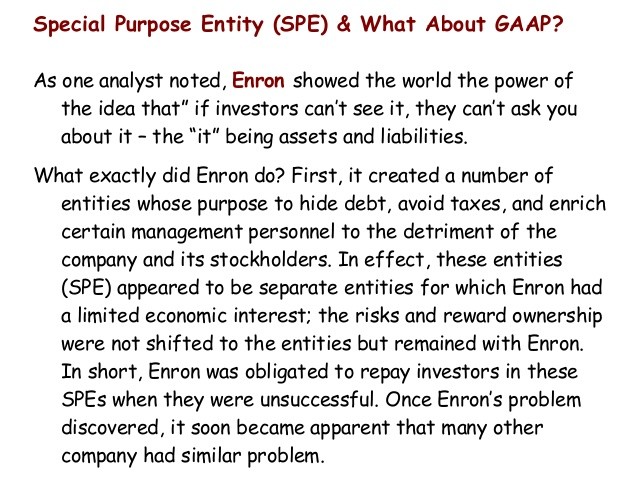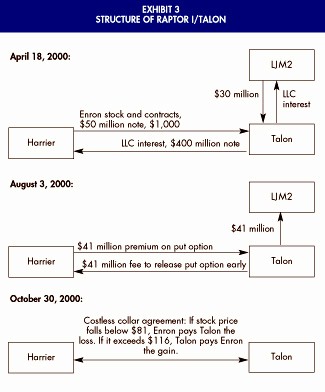Off Balance Sheet Financing with Special Purpose Entity (SPE)
Post on: 16 Март, 2015 No Comment

A financing transaction in which a debt obligation does not appear on the corporation’s balance sheet is referred to as an “off-balance-sheet financing ”. Some CEOs and CFOs believe that off-balance-sheet financing is ignored by market participants in evaluating the corporation’s capital structure (e.g. debt-to-equity ratios). To obtain the desired off-balance-sheet treatment, a corporation can establish a special-purpose entity (SPE). Why is SPE used to obtain an off-balance-sheet financing? This post gives brief reasoning and its related rules to follow .
An SPE can be a partnership or a trust .
Why Is Special Purpose Entity (SPE) Used To Obtain Off-balance-sheet Financing ?
SPE is used for three reasons :
- SPE can be used to reduce the cost of debt financing. For example . in an asset securitization transaction, the subject of the next chapter, a corporation seeking financing can sell assets that it has on its balance sheet to an SPE in an arm’s-length transaction. The SPE obtains the funds to purchase the assets from the corporation by issuing securities, called asset-backed securities. Since the SPE owns the assets, which then becomes the collateral for the securities issued, lenders evaluate the credit quality of the collateral and not the credit quality of the corporation. As a consequence, lower funding costs are possible. For example, a non-investment grade issuer can obtain funding at investment-grade levels by isolating the assets in the SPE. Also, as explained below, certain types of leasing offer this opportunity.
- SPE allows a corporation to shift risk from itself to third parties willing to accept the risk. An example of this is the use of an SPE to obtain funding for a major project, a financing transaction known as project financing or project finance. In this transaction, the lenders to the project look to the cash flow from the project rather than the cash flow of the corporation seeking financing.
- The transfer of tax benefits can be accomplished by using an SPE. In a lease arrangement, the lessor (i.e. the owner of the leased equipment) is entitled to the tax benefits associated with the ownership of the equipment if the lease qualifies as a true lease for tax purposes. Hence, a corporation that cannot use the tax benefits associated with ownership can transfer those benefits to another party by leasing equipment. in exchange for these tax benefits, the lessor provides a below market leasing rate that is less than the cost of borrowing funds in order to purchase the equipment.
Special Purpose Entity (SPE) on FIN 46

The issue is whether the Special Purpose Entity should be consolidated with the corporation. GAAP rules for consolidation before January 2003 required that a corporation consolidate if it had a “controlling financial interest ”. The definition of “controlling financial interest” was that the firm had a majority voting interest. Hence, under the pre-January 2003 rules set forth by GAAP, a corporation could be the primary beneficiary of the activities of an SPE, but absent a majority voting interest, consolidation was not necessary.
Enron used many SPEs for a variety of illegal purposes. Despite the fact that the other corporations were using SPE for legitimate purposes, the Enron bankruptcy prompted both the FASB and the SEC to reexamine the use of SPEs and the issue of consolidation. The FASB on January 17, 2003 issued FASB interpretation no. 46 [“Consolidation of Variable interest entities ”], referred to as “FIN 46 ”, which set forth a complex set of rules and principles for consolidation of what is referred to as “variable interest entities ”, one example being an SPE. If an SPE is consolidated, then the fair market value of the assets is reported on the corporation’s balance sheet as an asset. On the other side of the balance sheet, a fair value for the liability is recorded, as well as the fair market value of the minority interests in the SPE.
Fin 46 is complex and subject to interpretation. Basically. there are four questions that must be asked to determine whether a consolidation is required :
- Does the corporation have enough equity at risk in the SPE?
- Is the corporation allowed to make decisions about the activities of the SPE by either voting rights or similar rights?
- If the SPE incurs a loss, does the corporation have an obligation to absorb that loss?
- If there are any residual economic benefits expected from the activities of the SPE, does the corporation have the right to receive them?
If the answer to any of the above questions is affirmative, then consolidation is required.
Section 401(a) of the Sarbanes-Oxley (SOX) Act of 2002
With respect to off-balance-sheet transactions, Sarbanes-Oxley (SOX) requires that a company in its annual and quarterly filings with the SEC disclose all material off-balance sheet transactions, arrangements, obligations [including contingent obligations], and other relationships of the issuer with unconsolidated entities or other persons, that may have a material current or future effect on financial condition, changes in financial condition, results of operations, liquidity, capital expenditures, capital resources, or significant components of revenues or expenses .
The amendments to SOX address the lack of transparency of these transactions in a public company’s financial disclosure by requiring a discussion of them in a separate section within the management discussion and analysis section in SEC filings that it is reasonable to assume will have an effect on not only the firm’s financial condition but other matters material to investors.
According to the final regulations. with a greater understanding of a company’s off-balance sheet arrangements and contractual obligations. investors will be better able to understand how a company conducts significant aspects of its business and to assess the quality of a company’s earnings and the risks that are not apparent on the face of the financial statements.














